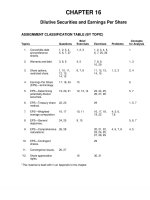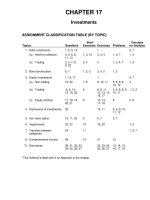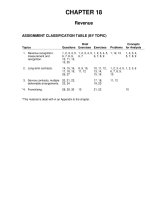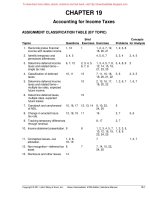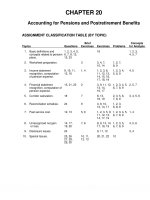Intermediate accounting IFRS 3rd ch22
Bạn đang xem bản rút gọn của tài liệu. Xem và tải ngay bản đầy đủ của tài liệu tại đây (2.95 MB, 75 trang )
Prepared by
Coby Harmon
University of California, Santa Barbara
Westmont College
22-1
CHAPTER 22
Accounting Changes and
Error Analysis
LEARNING OBJECTIVES
After studying this chapter, you should be able to:
1.
2.
22-2
Discuss the types of accounting
changes and the accounting for
changes in accounting policies.
Describe the accounting and
reporting for changes in
estimates.
3.
Describe the accounting for
correction of errors.
4.
Analyze the effect of errors.
PREVIEW OF CHAPTER 22
22-3
Intermediate Accounting
IFRS 3rd Edition
Kieso ● Weygandt ● Warfield
Accounting Changes
LEARNING OBJECTIVE 1
Discuss the types of accounting
changes and the accounting for
changes in accounting policies.
Background
Accounting Alternatives:
Diminish the comparability of financial information.
Obscure useful historical trend data.
Types of Accounting Changes:
1. Change in Accounting Policy.
2. Changes in Accounting Estimate.
Errors are not considered an accounting change.
22-4
LO 1
Changes In Accounting Policy
Change from one accepted accounting policy to another.
Examples include:
Average-cost to LIFO.
Cost-recovery to percentage-of-completion method.
Adoption of a new policy in recognition of events that have
occurred for the first time or that were previously immaterial is
not an accounting change.
22-5
LO 1
Changes In Accounting Policy
Three approaches for reporting changes:
1) Currently.
2) Retrospectively.
3) Prospectively (in the future).
IASB requires use of the retrospective approach.
Rationale - Users can then better compare results from one
period to the next.
22-6
LO 1
Changes In Accounting Policy
Retrospective Accounting Change Approach
Company reporting the change
1) Adjusts its financial statements for each prior period
presented to the same basis as the new accounting
policy.
2) Adjusts the carrying amounts of assets and liabilities as
of the beginning of the first year presented. Also makes
an offsetting adjustment to the opening balance of
retained earnings or other appropriate component of
equity or net assets as of the beginning of the first year
presented.
22-7
LO 1
Changes In Accounting Policy
Retrospective Accounting Change: Long-Term
Contracts
Illustration: Denson SA has accounted for its income from longterm construction contracts using the cost-recovery (zero-profit)
method. In 2019, the company changed to the percentage-ofcompletion method. Management believes this approach provides
a more appropriate measure of the income earned. For tax
purposes, the company uses the cost-recovery method and plans
to continue doing so in the future. (Assume a 40 percent enacted
tax rate.)
22-8
LO 1
Changes In Accounting Policy
22-9
ILLUSTRATION 22.1
Comparative Income
Statements for CostRecovery versus
Percentage-of-Completion
Methods
LO 1
Changes In Accounting Policy
Data for Retrospective Change Example
Journal entry
beginning of
2019
22-10
Construction in Process
Deferred Tax Liability
Retained Earnings
ILLUSTRATION 22.2
220,000
88,000
132,000
LO 1
Changes In Accounting Policy
Reporting a Change in Policy
Major disclosure requirements are as follows.
1.
Nature of the change in accounting principle.
2.
Reasons why applying the new accounting policy provides reliable
and more relevant information;
3.
For the current period and each prior period presented, to the extent
practicable, the amount of the adjustment:
4.
22-11
a)
For each financial statement line item affected; and
b)
Basic and diluted earnings per share.
The amount of the adjustment relating to periods before those
presented, to the extent practicable.
LO 1
ILLUSTRATION 22.3
Comparative Information Related to Accounting
Change (Percentage-of-Completion)
22-12
LO 1
Changes In Accounting Policy
Retained Earnings Adjustment
Retained earnings balance is €1,360,000 at the beginning of 2017.
Before Change
22-13
ILLUSTRATION 22.4
LO 1
Changes In Accounting Policy
Retained Earnings Adjustment
After Change
22-14
ILLUSTRATION 22.5
LO 1
Changes In Accounting Policy
Illustration: Cherokee Construction Company changed from the costrecovery to the percentage-of-completion method of accounting for
long-term construction contracts during 2019. For tax purposes, the
company employs the cost-recovery method and will continue this
approach in the future. (Hint: Adjust all tax consequences through the
Deferred Tax Liability account.) The appropriate information related to
this change is as follows.
2018
2019
22-15
LO 1
Changes In Accounting Policy
2018
2019
Instructions: (assume a tax rate of 35%)
(a) What entry(ies) are necessary to adjust the accounting records
for the change in accounting principle?
(b) What is the amount of net income and retained earnings that
would be reported in 2019? Assume beginning retained earnings
for 2018 to be $100,000.
22-16
LO 1
Changes In Accounting Policy
Pre-Tax Income from Long-Term Contracts
Journal entry (recorded in 2019)
Construction in Process 170,000
Deferred Tax Liability
Retained Earnings
22-17
59,500
110,500
LO 1
Changes In Accounting Policy
Comparative Statements
Income
Statement
Statement
of Retained
Earnings
22-18
LO 1
Changes In Accounting Policy
Retrospective Accounting Change: Inventory
Methods
Illustration: Lancer Company has accounted for its inventory
using the average-cost method. In 2019, the company changes to
the FIFO method because management believes this approach
provides a more appropriate measure of its inventory costs.
Additional information for Lancer Company:
1. Lancer Company started its operations on January 1, 2017. At
that time, shareholders invested $100,000 in the business in
exchange for ordinary shares.
22-19
ILLUSTRATION 22.6
Lancer Company Information
LO 1
Retrospective Change: Inventory Methods
Additional information for Lancer Company:
ILLUSTRATION 22.6
Lancer Company Information
2. All sales, purchases, and operating expenses for the period
2017–2019 are cash transactions. Lancer’s cash flows over
this period are as follows.
3. Lancer has used the average-cost method for financial
reporting since its inception.
22-20
LO 1
Retrospective Change: Inventory Methods
Additional information for Lancer Company:
ILLUSTRATION 22.6
Lancer Company Information
4. Inventory determined under average-cost and FIFO for the
period 2017–2019 is as follows.
22-21
LO 1
Retrospective Change: Inventory Methods
Additional information for Lancer Company:
ILLUSTRATION 22.6
Lancer Company Information
5. Cost of goods sold under average-cost and FIFO for the period
2017–2019 is as follows.
6. Earnings per share is not required on the income statement.
7. All tax effects for this illustration should be ignored.
22-22
LO 1
Given the information about Lancer Company.
22-23
ILLUSTRATION 22.7
Lancer Financial Statements
(Average-Cost)
LO 1
ILLUSTRATION 22.7
22-24
LO 1
Retrospective Change: Inventory Methods
Illustration 22.8 (to follow) shows Lancer’s income statement,
retained earnings statement, statement of financial position, and
statement of cash flows for 2017–2019 under FIFO.
22-25
•
The cash flow statement under FIFO is the same as under
average-cost.
•
Net incomes are different in each period.
•
There is no cash flow effect from these differences in net
income. (If we considered income taxes, a cash flow effect
would result.)
LO 1





